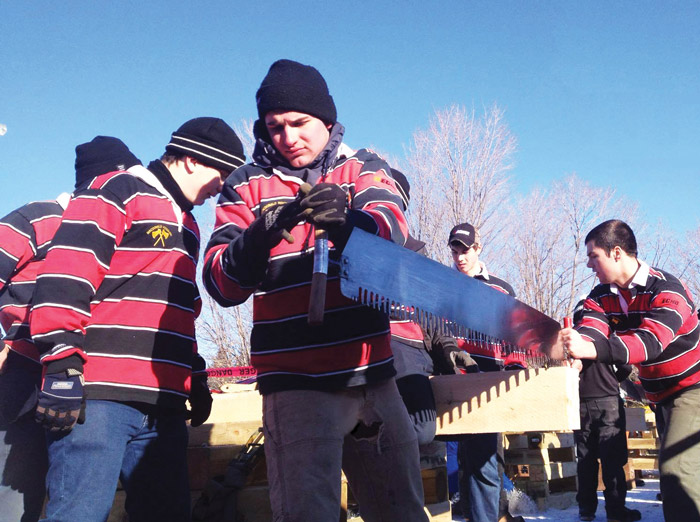It was a perfect day for chopping wood. The crisp cold made the lumberjacks and lumberjills grip their axes tighter and the crowd huddled closely on the hard-packed ground breathing lungfuls of pine air. Kids climbed on snow mounds and men sipped coffee from their thermoses. In the distance, some students on cross country skis set off across the wide snowy fields of Macdonald Campus.
The teams hunched over, primed to start their chopping, and the emcee counted down the start of the 56th annual Intercollegiate Woodsmen Competition.
The Canadian Intercollegiate Lumberjacking Association (CILA) holds four major events each year and the team with the most cumulative points is crowned the overall winner. On Saturday, McGill competed against Dalhousie, Sir Sanford Fleming College, Algonquin College, University of New Brunswick, and Dartmouth College in the second to last event of the season. The stakes were high, but Sebastien Latraverse, a third-year student in the farm management and technology program at Macdonald campus, was loose and limber among the lumber.
“We practice every morning at six a.m., we do cardio, run through our events, [… and] basically just chop wood,” he said.
Despite the pressure and the cold, every athlete competing was completely at home–especially when swinging an axe with all their might at a block of wood between their boots, or steadying a log with their bare fingers inches from a chainsaw. They held their axes in their hands with the easy comfort of a baseball player holding a bat, like extensions of their own bodies; but while a bat can only hit a ball, an axe can keep you warm and give you shelter.
Unlike the major televised sports in North America, lumberjacking was not conceived of as a game. It’s a set of skills that supported our survival in the wilderness, in a time not so long ago. It’s not something you practiced for fun or for glory. It’s only a sport because one day, some person said to another, “I bet I can chop that tree down with this axe faster than you can.”
Out of the 14 events in the competition, the McGill women’s team won the snowshoe, swede saw, crosscut saw, quart split, and underhand chop events and placed first with the most overall points. The men came third overall, with strong performances in the single buck, snow shoe, and swede saw events. Latraverse was confident about the team’s position heading into the final CILA competition at Dalhousie in February.
“Overall we have a really good team this year, we get a lot of points in every event and that’s what counts,” Latraverse said.
Not every event involved the cutting or chopping of wood. The most entertaining competition of the day was the water boil, a singles event where each lumberjack is given a small cedar block, a hatchet, and three matches and has to bring a cup of water to boil as fast as possible. The pole climb and the axe throw are pretty self explanatory—and pretty ridiculous to watch.
Some of the coolest events are rooted in interesting history. Log decking, which involves maneuvering a log up a ramp using a peavey (a logging tool that looks like a trident split in half), was an essential skill for lumberjacks trying to float massive trees down rivers. The underhand chop, where the lumberjack stands on top of a log and must break it in half by hacking into both ends, goes back to before saws were invented and when axes were used to cut wood to the desired length.
While McGill’s Woodsmen and Woodswomen are mostly Mac campus students, some Engineering students travel back and forth from the Downtown campus, and Latraverse encourages anyone interested to join.
“A lot of people who have never used a chainsaw or held an axe, we show them what to do, and if you stick with it you’ll get it eventually,” he said.









